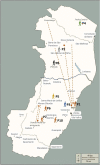Paracoccidioidomycosis cases by Paracoccidioides lutzii in southeastern Brazil
- PMID: 37289316
- PMCID: PMC10485217
- DOI: 10.1007/s42770-023-01019-w
Paracoccidioidomycosis cases by Paracoccidioides lutzii in southeastern Brazil
Erratum in
-
Correction to: Paracoccidioidomycosis cases by Paracoccidioides lutzii in southeastern Brazil.Braz J Microbiol. 2023 Sep;54(3):2535-2536. doi: 10.1007/s42770-023-01043-w. Braz J Microbiol. 2023. PMID: 37460870 Free PMC article. No abstract available.
Abstract
Background and objective: Paracoccidioidomycosis (PCM) is a systemic fungal disease caused by the thermodimorphic fungi Paracoccidioides spp. Their distribution is highly variable. Paracoccidioides lutzii is predominantly found in North and Middle-West Brazil and Ecuador. This study evaluated the clinicopathological characteristics of 10 patients diagnosed with PCM caused by P. lutzii in a reference center located in southeastern Brazil.
Design: Double immunodiffusion assay (DID) was used to investigate 35 patients' sera with negative serology for P. brasiliensis against a P. lutzii CFA (cell-free antigen).
Results: Out of the 35 retested patients, 10 (28.6%) were positive for P. lutzii CFA. Four patients did not report any displacement to P. lutzii endemic areas. Our results reinforce the importance of using different antigens when testing patients with clinical manifestations of PCM and negative serological tests for P. brasiliensis, primarily in cases of the report of displacement to or former residence in P. lutzii endemic regions.
Conclusions: The availability of tests for different Paracoccidioides species antigens is fundamental for reaching an adequate diagnosis, patient follow-up, and definition of prognosis.
Keywords: Double immunodiffusion assay; Endemic mycosis; Paracoccidioides lutzii; Paracoccidioidomycosis.
© 2023. The Author(s) under exclusive licence to Sociedade Brasileira de Microbiologia.
Conflict of interest statement
The authors declare no competing interests.
Figures
Similar articles
-
Serology of paracoccidioidomycosis due to Paracoccidioides lutzii.PLoS Negl Trop Dis. 2014 Jul 17;8(7):e2986. doi: 10.1371/journal.pntd.0002986. eCollection 2014 Jul. PLoS Negl Trop Dis. 2014. PMID: 25032829 Free PMC article.
-
Comparison of clinico-epidemiological and radiological features in paracoccidioidomycosis patients regarding serological classification using antigens from Paracoccidioides brasiliensis complex and Paracoccidioides lutzii.PLoS Negl Trop Dis. 2020 Aug 25;14(8):e0008485. doi: 10.1371/journal.pntd.0008485. eCollection 2020 Aug. PLoS Negl Trop Dis. 2020. PMID: 32841237 Free PMC article.
-
IgG reactivity profile to Paracoccidioides spp. antigens in people with asymptomatic Paracoccidioidomycosis.J Med Microbiol. 2021 Jan;70(1). doi: 10.1099/jmm.0.001279. J Med Microbiol. 2021. PMID: 33258768
-
Advances and challenges in paracoccidioidomycosis serology caused by Paracoccidioides species complex: an update.Diagn Microbiol Infect Dis. 2016 Jan;84(1):87-94. doi: 10.1016/j.diagmicrobio.2015.06.004. Epub 2015 Jun 12. Diagn Microbiol Infect Dis. 2016. PMID: 26494541 Review.
-
Paracoccidioidomycosis: Current Status and Future Trends.Clin Microbiol Rev. 2022 Dec 21;35(4):e0023321. doi: 10.1128/cmr.00233-21. Epub 2022 Sep 8. Clin Microbiol Rev. 2022. PMID: 36074014 Free PMC article. Review.
References
MeSH terms
Substances
Supplementary concepts
LinkOut - more resources
Full Text Sources
Miscellaneous


